Analyzing Alibaba’s Strategic Success in Global E-Commerce
VerifiedAdded on 2020/04/21
|45
|16540
|89
AI Summary
Alibaba has emerged as a dominant force in the e-commerce sector through a series of strategic maneuvers and innovative approaches that have facilitated its international growth and success. This analysis explores Alibaba’s journey from its inception to becoming a global powerhouse by examining key factors such as platform synergy, IT infrastructure, and effective use of network ties and firm ownership strategies. The company's ability to integrate electronic commerce with IT platforms has been pivotal in driving significant events like 'Singles’ Day', contributing to its expansive reach across diverse markets. This paper also assesses Alibaba’s adaptability and strategic alliances that have underpinned its sustained success, focusing on how these elements synergize to create a robust business model capable of navigating complex international landscapes.

Business Management and Strategy
Paraphrase This Document
Need a fresh take? Get an instant paraphrase of this document with our AI Paraphraser

Business Management and Strategy 1
Abstract
The key purpose of this report is to understand the meaning and significance of
internationalisation. In present time going global is one of the best way to enhance the revues,
business roots and the customer base. There are a number of companies which expand their
business in the foreign regions and attain huge growth and success in a short span of time. The
paper will present the introduction part with the brief explanation of internationalisation of
businesses. The next part of the report is the literature review which offers a detailed description
of the process of internationalisation and the various strategies of internationalisation. The
following part of the literature will throw lights upon the reasons and key factor which are
responsible behind the internationalisation of the companies. The next part will explain the key
benefits associated with the business internationalisation. In the second part of the report, there is
case study analysis where the report will present the case of Alibaba and its internationalisation.
There will also be present the case of three internet firms and the manner in which they have
attained huge growth through internationalisation. The report will end with a brief conclusion
with some recommendations.
Abstract
The key purpose of this report is to understand the meaning and significance of
internationalisation. In present time going global is one of the best way to enhance the revues,
business roots and the customer base. There are a number of companies which expand their
business in the foreign regions and attain huge growth and success in a short span of time. The
paper will present the introduction part with the brief explanation of internationalisation of
businesses. The next part of the report is the literature review which offers a detailed description
of the process of internationalisation and the various strategies of internationalisation. The
following part of the literature will throw lights upon the reasons and key factor which are
responsible behind the internationalisation of the companies. The next part will explain the key
benefits associated with the business internationalisation. In the second part of the report, there is
case study analysis where the report will present the case of Alibaba and its internationalisation.
There will also be present the case of three internet firms and the manner in which they have
attained huge growth through internationalisation. The report will end with a brief conclusion
with some recommendations.
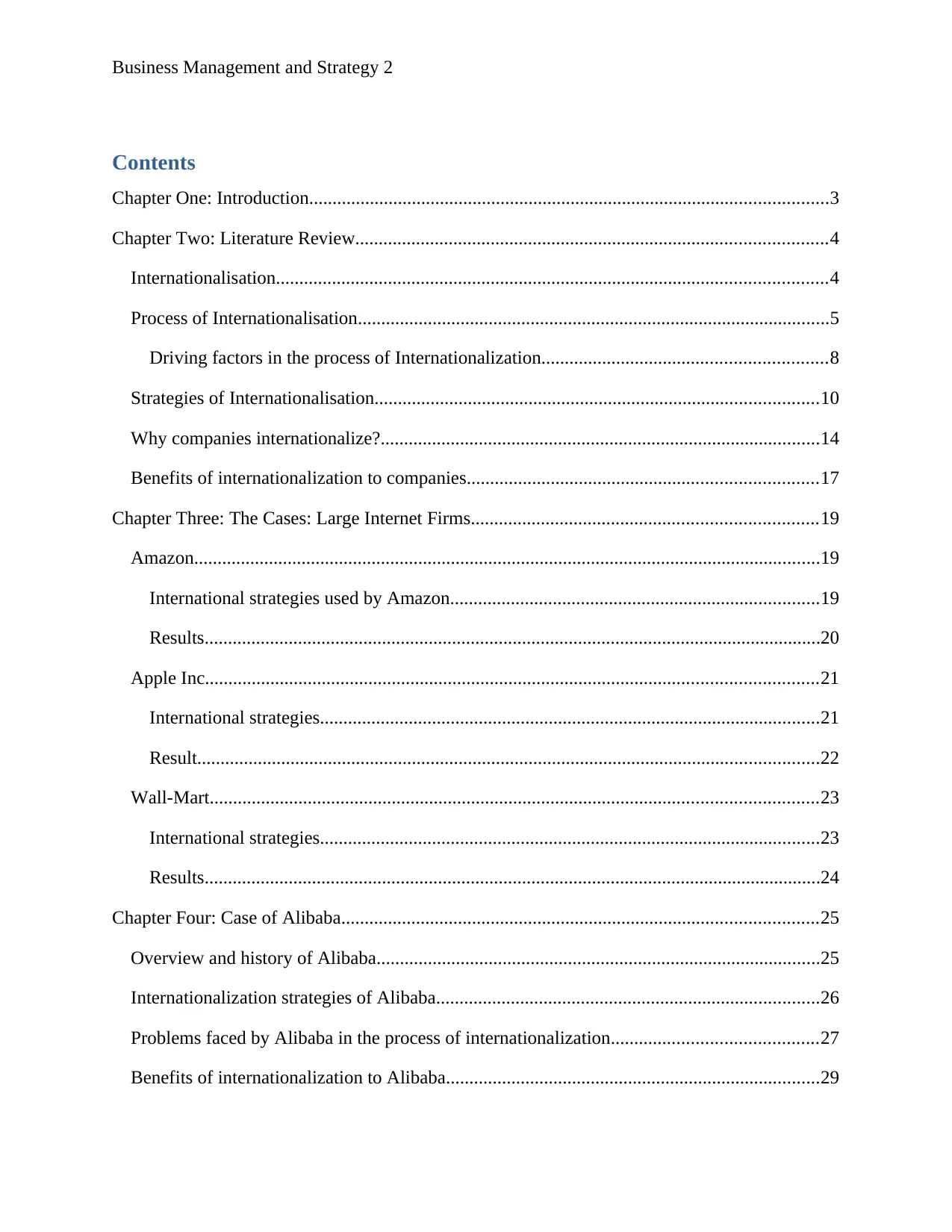
Business Management and Strategy 2
Contents
Chapter One: Introduction...............................................................................................................3
Chapter Two: Literature Review.....................................................................................................4
Internationalisation......................................................................................................................4
Process of Internationalisation.....................................................................................................5
Driving factors in the process of Internationalization.............................................................8
Strategies of Internationalisation...............................................................................................10
Why companies internationalize?..............................................................................................14
Benefits of internationalization to companies...........................................................................17
Chapter Three: The Cases: Large Internet Firms..........................................................................19
Amazon......................................................................................................................................19
International strategies used by Amazon...............................................................................19
Results....................................................................................................................................20
Apple Inc...................................................................................................................................21
International strategies...........................................................................................................21
Result.....................................................................................................................................22
Wall-Mart..................................................................................................................................23
International strategies...........................................................................................................23
Results....................................................................................................................................24
Chapter Four: Case of Alibaba......................................................................................................25
Overview and history of Alibaba...............................................................................................25
Internationalization strategies of Alibaba..................................................................................26
Problems faced by Alibaba in the process of internationalization............................................27
Benefits of internationalization to Alibaba................................................................................29
Contents
Chapter One: Introduction...............................................................................................................3
Chapter Two: Literature Review.....................................................................................................4
Internationalisation......................................................................................................................4
Process of Internationalisation.....................................................................................................5
Driving factors in the process of Internationalization.............................................................8
Strategies of Internationalisation...............................................................................................10
Why companies internationalize?..............................................................................................14
Benefits of internationalization to companies...........................................................................17
Chapter Three: The Cases: Large Internet Firms..........................................................................19
Amazon......................................................................................................................................19
International strategies used by Amazon...............................................................................19
Results....................................................................................................................................20
Apple Inc...................................................................................................................................21
International strategies...........................................................................................................21
Result.....................................................................................................................................22
Wall-Mart..................................................................................................................................23
International strategies...........................................................................................................23
Results....................................................................................................................................24
Chapter Four: Case of Alibaba......................................................................................................25
Overview and history of Alibaba...............................................................................................25
Internationalization strategies of Alibaba..................................................................................26
Problems faced by Alibaba in the process of internationalization............................................27
Benefits of internationalization to Alibaba................................................................................29
⊘ This is a preview!⊘
Do you want full access?
Subscribe today to unlock all pages.

Trusted by 1+ million students worldwide

Business Management and Strategy 3
Future plans of Alibaba in relation to internationalization........................................................31
Recommendations......................................................................................................................33
Conclusion.....................................................................................................................................33
Bibliography..................................................................................................................................35
Future plans of Alibaba in relation to internationalization........................................................31
Recommendations......................................................................................................................33
Conclusion.....................................................................................................................................33
Bibliography..................................................................................................................................35
Paraphrase This Document
Need a fresh take? Get an instant paraphrase of this document with our AI Paraphraser

Business Management and Strategy 4
Chapter One: Introduction
The international market is attaining huge significance and popularity as a business market and a
base for globally performing companies as well as for those organisations who wants to become
global. At a similar point of time, there are various companies in the world that supports the
international economy with their technological and economic significance. By analyzing the
strategic management of the globally active companies, it is revealed that there are huge
investments in the international market are shaped by the modern trends in the
internationalization of the organisations and the upsurge international competition. The
organisations are acknowledged and recognized in a number of ways and primarily from the
perspective of internationalization which is presently given huge attention by various theorists,
business people, academicians and scholars (Alexander and Doherty, 2009). The organisations
play a significant role in the globalized economy as maximum of them are going global or at
least have an idea of going global and have international business operations. The organisations
have increased their business operations in the global markets and are taking use of
diversification to attain a number of competitive benefits and success and growth in the global
markets. The one of the most recent trends and development in the business world is the use of
internet in the businesses. There are companies which have initiated their businesses by the use
of internet called as ecommerce which is extremely beneficial and advantageous in achieving
growth and sustainability in the globalized economy (Barkema and Drogendijk, 2007). The
impact of internet on the business strategies is considered as the “innovation of the century”. It is
due to the fact that the internet has sparked the information and the communication revolution. It
has laid a huge emphasis on the businesses to essentially change the value creation model as it is
regarded as both an opportunity as well as a threat. Internationalization is one of the most
interested and favored aspect of all the companies or business organisations. There is no
particular or specific definition which can explain the exact or true meaning of
internationalization. But from an overall perspective and from the economic point of view,
internationalization is an approach where the business increased its involvement in the global
markets. In this thesis, there will be discussed the role of international business and particularly
the growing markets as an innovative and significant business operation for the organisations
across the world will be discussed. In present time, there are several technological advancements
Chapter One: Introduction
The international market is attaining huge significance and popularity as a business market and a
base for globally performing companies as well as for those organisations who wants to become
global. At a similar point of time, there are various companies in the world that supports the
international economy with their technological and economic significance. By analyzing the
strategic management of the globally active companies, it is revealed that there are huge
investments in the international market are shaped by the modern trends in the
internationalization of the organisations and the upsurge international competition. The
organisations are acknowledged and recognized in a number of ways and primarily from the
perspective of internationalization which is presently given huge attention by various theorists,
business people, academicians and scholars (Alexander and Doherty, 2009). The organisations
play a significant role in the globalized economy as maximum of them are going global or at
least have an idea of going global and have international business operations. The organisations
have increased their business operations in the global markets and are taking use of
diversification to attain a number of competitive benefits and success and growth in the global
markets. The one of the most recent trends and development in the business world is the use of
internet in the businesses. There are companies which have initiated their businesses by the use
of internet called as ecommerce which is extremely beneficial and advantageous in achieving
growth and sustainability in the globalized economy (Barkema and Drogendijk, 2007). The
impact of internet on the business strategies is considered as the “innovation of the century”. It is
due to the fact that the internet has sparked the information and the communication revolution. It
has laid a huge emphasis on the businesses to essentially change the value creation model as it is
regarded as both an opportunity as well as a threat. Internationalization is one of the most
interested and favored aspect of all the companies or business organisations. There is no
particular or specific definition which can explain the exact or true meaning of
internationalization. But from an overall perspective and from the economic point of view,
internationalization is an approach where the business increased its involvement in the global
markets. In this thesis, there will be discussed the role of international business and particularly
the growing markets as an innovative and significant business operation for the organisations
across the world will be discussed. In present time, there are several technological advancements
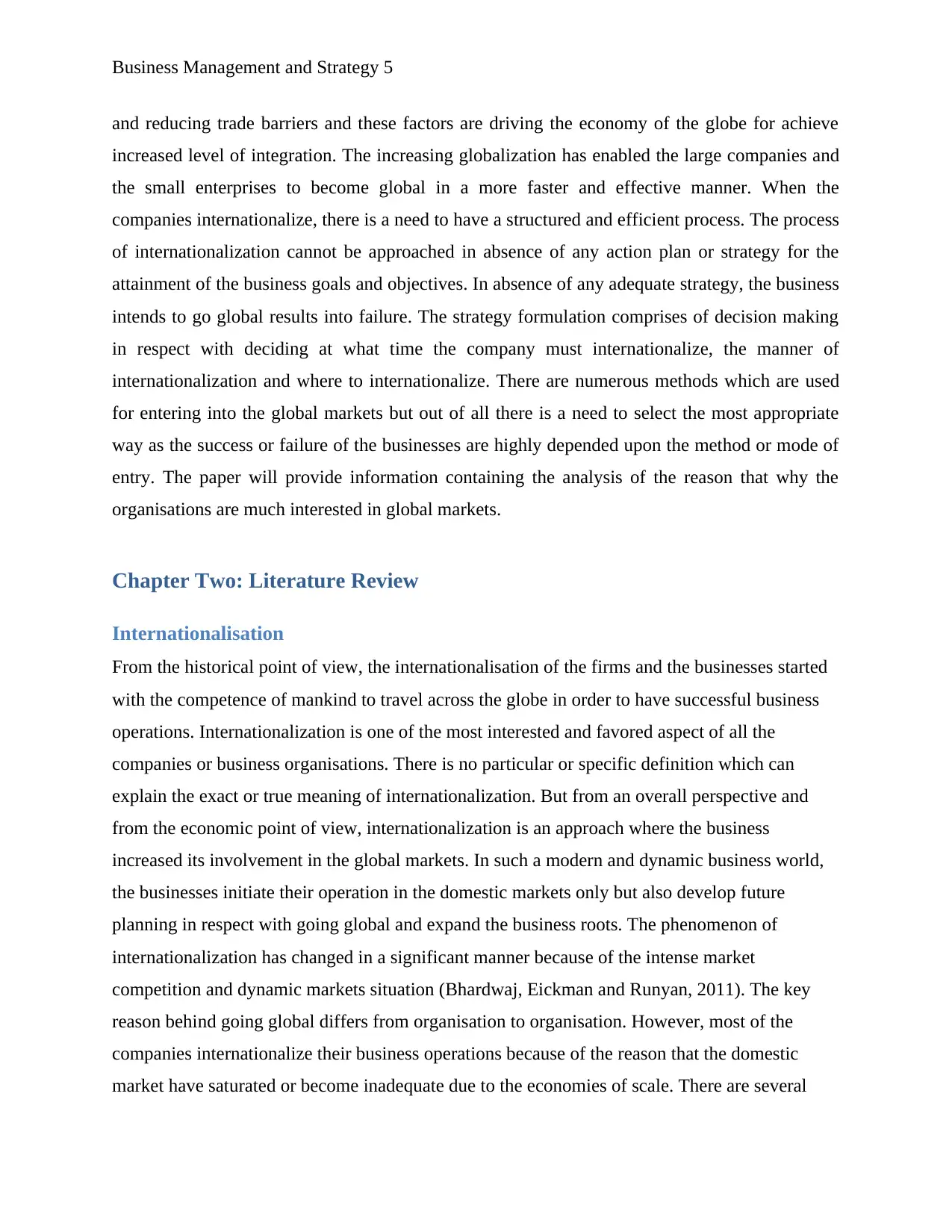
Business Management and Strategy 5
and reducing trade barriers and these factors are driving the economy of the globe for achieve
increased level of integration. The increasing globalization has enabled the large companies and
the small enterprises to become global in a more faster and effective manner. When the
companies internationalize, there is a need to have a structured and efficient process. The process
of internationalization cannot be approached in absence of any action plan or strategy for the
attainment of the business goals and objectives. In absence of any adequate strategy, the business
intends to go global results into failure. The strategy formulation comprises of decision making
in respect with deciding at what time the company must internationalize, the manner of
internationalization and where to internationalize. There are numerous methods which are used
for entering into the global markets but out of all there is a need to select the most appropriate
way as the success or failure of the businesses are highly depended upon the method or mode of
entry. The paper will provide information containing the analysis of the reason that why the
organisations are much interested in global markets.
Chapter Two: Literature Review
Internationalisation
From the historical point of view, the internationalisation of the firms and the businesses started
with the competence of mankind to travel across the globe in order to have successful business
operations. Internationalization is one of the most interested and favored aspect of all the
companies or business organisations. There is no particular or specific definition which can
explain the exact or true meaning of internationalization. But from an overall perspective and
from the economic point of view, internationalization is an approach where the business
increased its involvement in the global markets. In such a modern and dynamic business world,
the businesses initiate their operation in the domestic markets only but also develop future
planning in respect with going global and expand the business roots. The phenomenon of
internationalization has changed in a significant manner because of the intense market
competition and dynamic markets situation (Bhardwaj, Eickman and Runyan, 2011). The key
reason behind going global differs from organisation to organisation. However, most of the
companies internationalize their business operations because of the reason that the domestic
market have saturated or become inadequate due to the economies of scale. There are several
and reducing trade barriers and these factors are driving the economy of the globe for achieve
increased level of integration. The increasing globalization has enabled the large companies and
the small enterprises to become global in a more faster and effective manner. When the
companies internationalize, there is a need to have a structured and efficient process. The process
of internationalization cannot be approached in absence of any action plan or strategy for the
attainment of the business goals and objectives. In absence of any adequate strategy, the business
intends to go global results into failure. The strategy formulation comprises of decision making
in respect with deciding at what time the company must internationalize, the manner of
internationalization and where to internationalize. There are numerous methods which are used
for entering into the global markets but out of all there is a need to select the most appropriate
way as the success or failure of the businesses are highly depended upon the method or mode of
entry. The paper will provide information containing the analysis of the reason that why the
organisations are much interested in global markets.
Chapter Two: Literature Review
Internationalisation
From the historical point of view, the internationalisation of the firms and the businesses started
with the competence of mankind to travel across the globe in order to have successful business
operations. Internationalization is one of the most interested and favored aspect of all the
companies or business organisations. There is no particular or specific definition which can
explain the exact or true meaning of internationalization. But from an overall perspective and
from the economic point of view, internationalization is an approach where the business
increased its involvement in the global markets. In such a modern and dynamic business world,
the businesses initiate their operation in the domestic markets only but also develop future
planning in respect with going global and expand the business roots. The phenomenon of
internationalization has changed in a significant manner because of the intense market
competition and dynamic markets situation (Bhardwaj, Eickman and Runyan, 2011). The key
reason behind going global differs from organisation to organisation. However, most of the
companies internationalize their business operations because of the reason that the domestic
market have saturated or become inadequate due to the economies of scale. There are several
⊘ This is a preview!⊘
Do you want full access?
Subscribe today to unlock all pages.

Trusted by 1+ million students worldwide
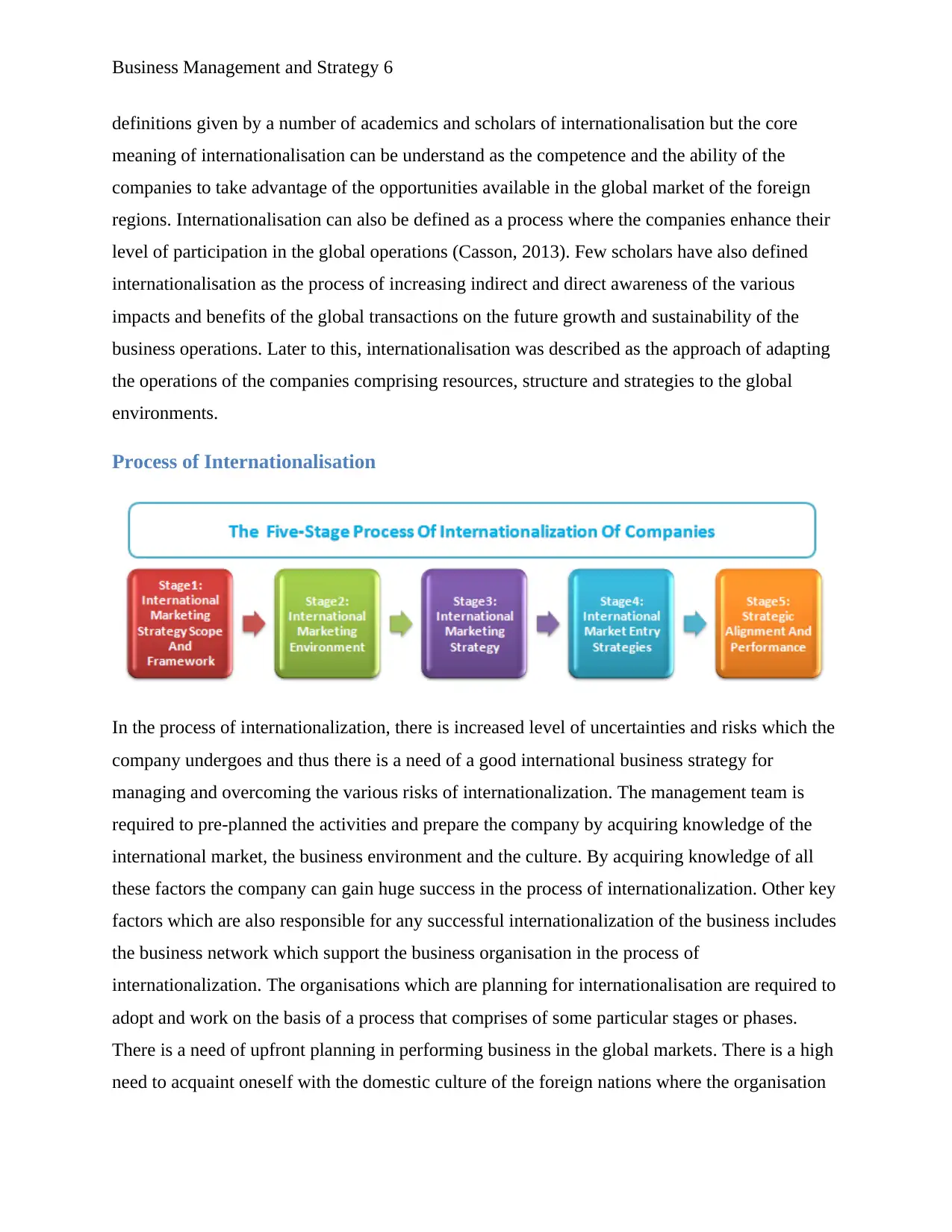
Business Management and Strategy 6
definitions given by a number of academics and scholars of internationalisation but the core
meaning of internationalisation can be understand as the competence and the ability of the
companies to take advantage of the opportunities available in the global market of the foreign
regions. Internationalisation can also be defined as a process where the companies enhance their
level of participation in the global operations (Casson, 2013). Few scholars have also defined
internationalisation as the process of increasing indirect and direct awareness of the various
impacts and benefits of the global transactions on the future growth and sustainability of the
business operations. Later to this, internationalisation was described as the approach of adapting
the operations of the companies comprising resources, structure and strategies to the global
environments.
Process of Internationalisation
In the process of internationalization, there is increased level of uncertainties and risks which the
company undergoes and thus there is a need of a good international business strategy for
managing and overcoming the various risks of internationalization. The management team is
required to pre-planned the activities and prepare the company by acquiring knowledge of the
international market, the business environment and the culture. By acquiring knowledge of all
these factors the company can gain huge success in the process of internationalization. Other key
factors which are also responsible for any successful internationalization of the business includes
the business network which support the business organisation in the process of
internationalization. The organisations which are planning for internationalisation are required to
adopt and work on the basis of a process that comprises of some particular stages or phases.
There is a need of upfront planning in performing business in the global markets. There is a high
need to acquaint oneself with the domestic culture of the foreign nations where the organisation
definitions given by a number of academics and scholars of internationalisation but the core
meaning of internationalisation can be understand as the competence and the ability of the
companies to take advantage of the opportunities available in the global market of the foreign
regions. Internationalisation can also be defined as a process where the companies enhance their
level of participation in the global operations (Casson, 2013). Few scholars have also defined
internationalisation as the process of increasing indirect and direct awareness of the various
impacts and benefits of the global transactions on the future growth and sustainability of the
business operations. Later to this, internationalisation was described as the approach of adapting
the operations of the companies comprising resources, structure and strategies to the global
environments.
Process of Internationalisation
In the process of internationalization, there is increased level of uncertainties and risks which the
company undergoes and thus there is a need of a good international business strategy for
managing and overcoming the various risks of internationalization. The management team is
required to pre-planned the activities and prepare the company by acquiring knowledge of the
international market, the business environment and the culture. By acquiring knowledge of all
these factors the company can gain huge success in the process of internationalization. Other key
factors which are also responsible for any successful internationalization of the business includes
the business network which support the business organisation in the process of
internationalization. The organisations which are planning for internationalisation are required to
adopt and work on the basis of a process that comprises of some particular stages or phases.
There is a need of upfront planning in performing business in the global markets. There is a high
need to acquaint oneself with the domestic culture of the foreign nations where the organisation
Paraphrase This Document
Need a fresh take? Get an instant paraphrase of this document with our AI Paraphraser

Business Management and Strategy 7
is planning to expand its business that comprises of everything from search engine mechanisms
to the business practices (Cavusgil, et al., 2014). The approach by which the companies go
global is known as the process of internationalisation and this process comprises of five specific
stages. The five stages include international marketing strategy scope and framework,
international marketing environment, international marketing strategy, international market entry
strategy and strategic alignment and performance. Following is the adequate and in-depth
description of all the stages of the internationalization process.
Stage1: International Marketing Strategy Scope and Framework
In the first phase or step of the process of internationalisation, there is development of a strategy
scope and framework which means that the company analysed the regions or the overseas
nations and evaluate whether there is a scope for international business or not and if a scope is
identified to perform business, there is development of a marketing framework which comprises
of the complete structure in the manner in which the company will initiate or start performing its
business in the overseas nation (Contractor, 2007).
Stage2: International Marketing Environment
In the second phase or step of the process of internationalisation, there is analysis of the
international marketing environment where the company analyse the resources and the
capabilities of the organisation so that it can have improved and effective business operations in
the overseas region. The second analysis in the evaluation of the marketing environment is the
analysis of the global competitors where the company analyse the various competitors which are
already there in the host country who can have a direct impact on the business functioning of the
organisation. The third key factor in the marketing environment is the culture which is required
to be managed as there are several cross cultural issues in the global business functions and
international businesses. Buy achieving effective cross cultural balance, the business achieve
high level of sustainability. The next factor in the international marketing environment is to
create and develop competitive benefits which are one of the major factors in achieving success
in the international business (Dachs, Stehrer and Zahradnik, 2014). It is also necessary to analyse
the various uncertainties and the political risks associated in the global business as in the process
of internationalisation, the companies face a number of risk which are required to be analysed,
is planning to expand its business that comprises of everything from search engine mechanisms
to the business practices (Cavusgil, et al., 2014). The approach by which the companies go
global is known as the process of internationalisation and this process comprises of five specific
stages. The five stages include international marketing strategy scope and framework,
international marketing environment, international marketing strategy, international market entry
strategy and strategic alignment and performance. Following is the adequate and in-depth
description of all the stages of the internationalization process.
Stage1: International Marketing Strategy Scope and Framework
In the first phase or step of the process of internationalisation, there is development of a strategy
scope and framework which means that the company analysed the regions or the overseas
nations and evaluate whether there is a scope for international business or not and if a scope is
identified to perform business, there is development of a marketing framework which comprises
of the complete structure in the manner in which the company will initiate or start performing its
business in the overseas nation (Contractor, 2007).
Stage2: International Marketing Environment
In the second phase or step of the process of internationalisation, there is analysis of the
international marketing environment where the company analyse the resources and the
capabilities of the organisation so that it can have improved and effective business operations in
the overseas region. The second analysis in the evaluation of the marketing environment is the
analysis of the global competitors where the company analyse the various competitors which are
already there in the host country who can have a direct impact on the business functioning of the
organisation. The third key factor in the marketing environment is the culture which is required
to be managed as there are several cross cultural issues in the global business functions and
international businesses. Buy achieving effective cross cultural balance, the business achieve
high level of sustainability. The next factor in the international marketing environment is to
create and develop competitive benefits which are one of the major factors in achieving success
in the international business (Dachs, Stehrer and Zahradnik, 2014). It is also necessary to analyse
the various uncertainties and the political risks associated in the global business as in the process
of internationalisation, the companies face a number of risk which are required to be analysed,
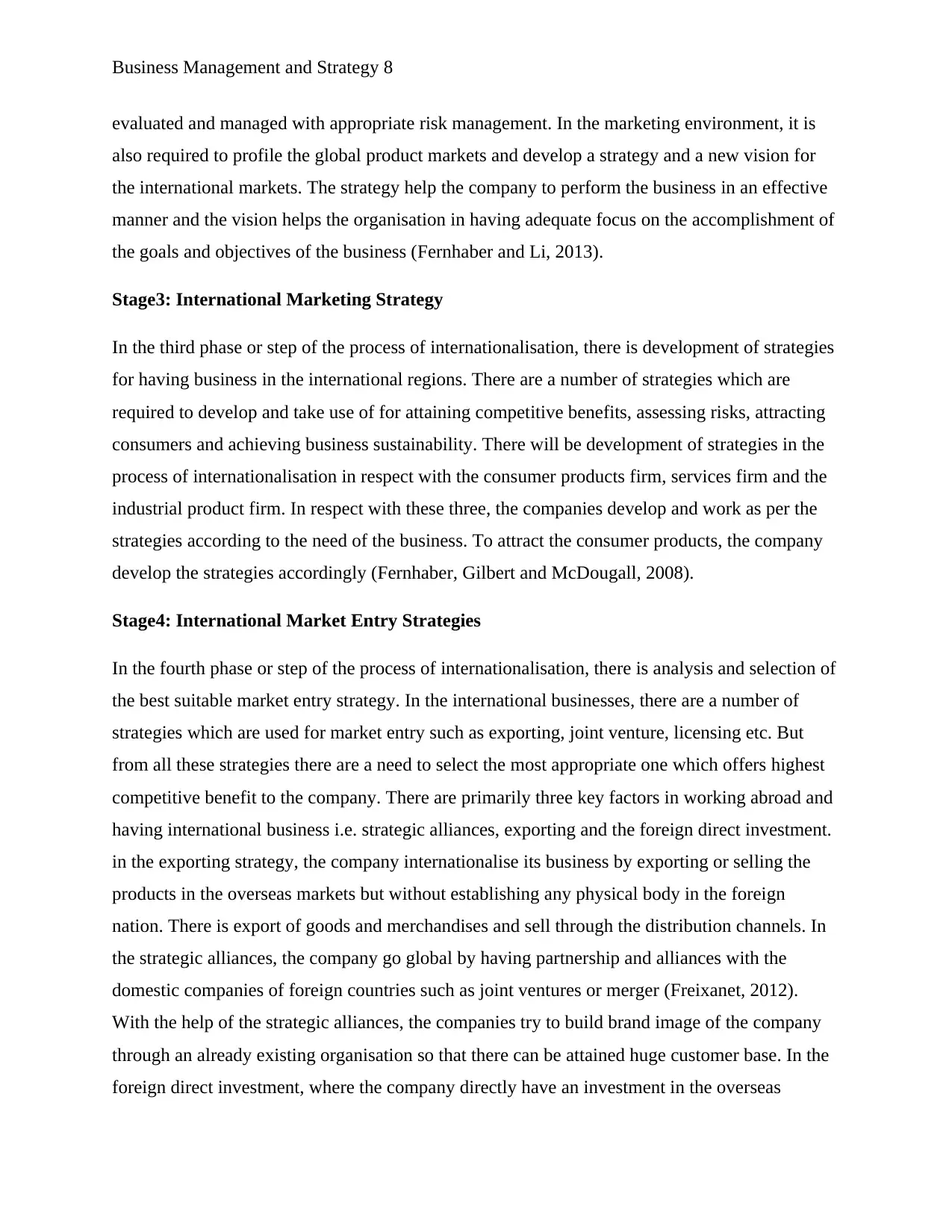
Business Management and Strategy 8
evaluated and managed with appropriate risk management. In the marketing environment, it is
also required to profile the global product markets and develop a strategy and a new vision for
the international markets. The strategy help the company to perform the business in an effective
manner and the vision helps the organisation in having adequate focus on the accomplishment of
the goals and objectives of the business (Fernhaber and Li, 2013).
Stage3: International Marketing Strategy
In the third phase or step of the process of internationalisation, there is development of strategies
for having business in the international regions. There are a number of strategies which are
required to develop and take use of for attaining competitive benefits, assessing risks, attracting
consumers and achieving business sustainability. There will be development of strategies in the
process of internationalisation in respect with the consumer products firm, services firm and the
industrial product firm. In respect with these three, the companies develop and work as per the
strategies according to the need of the business. To attract the consumer products, the company
develop the strategies accordingly (Fernhaber, Gilbert and McDougall, 2008).
Stage4: International Market Entry Strategies
In the fourth phase or step of the process of internationalisation, there is analysis and selection of
the best suitable market entry strategy. In the international businesses, there are a number of
strategies which are used for market entry such as exporting, joint venture, licensing etc. But
from all these strategies there are a need to select the most appropriate one which offers highest
competitive benefit to the company. There are primarily three key factors in working abroad and
having international business i.e. strategic alliances, exporting and the foreign direct investment.
in the exporting strategy, the company internationalise its business by exporting or selling the
products in the overseas markets but without establishing any physical body in the foreign
nation. There is export of goods and merchandises and sell through the distribution channels. In
the strategic alliances, the company go global by having partnership and alliances with the
domestic companies of foreign countries such as joint ventures or merger (Freixanet, 2012).
With the help of the strategic alliances, the companies try to build brand image of the company
through an already existing organisation so that there can be attained huge customer base. In the
foreign direct investment, where the company directly have an investment in the overseas
evaluated and managed with appropriate risk management. In the marketing environment, it is
also required to profile the global product markets and develop a strategy and a new vision for
the international markets. The strategy help the company to perform the business in an effective
manner and the vision helps the organisation in having adequate focus on the accomplishment of
the goals and objectives of the business (Fernhaber and Li, 2013).
Stage3: International Marketing Strategy
In the third phase or step of the process of internationalisation, there is development of strategies
for having business in the international regions. There are a number of strategies which are
required to develop and take use of for attaining competitive benefits, assessing risks, attracting
consumers and achieving business sustainability. There will be development of strategies in the
process of internationalisation in respect with the consumer products firm, services firm and the
industrial product firm. In respect with these three, the companies develop and work as per the
strategies according to the need of the business. To attract the consumer products, the company
develop the strategies accordingly (Fernhaber, Gilbert and McDougall, 2008).
Stage4: International Market Entry Strategies
In the fourth phase or step of the process of internationalisation, there is analysis and selection of
the best suitable market entry strategy. In the international businesses, there are a number of
strategies which are used for market entry such as exporting, joint venture, licensing etc. But
from all these strategies there are a need to select the most appropriate one which offers highest
competitive benefit to the company. There are primarily three key factors in working abroad and
having international business i.e. strategic alliances, exporting and the foreign direct investment.
in the exporting strategy, the company internationalise its business by exporting or selling the
products in the overseas markets but without establishing any physical body in the foreign
nation. There is export of goods and merchandises and sell through the distribution channels. In
the strategic alliances, the company go global by having partnership and alliances with the
domestic companies of foreign countries such as joint ventures or merger (Freixanet, 2012).
With the help of the strategic alliances, the companies try to build brand image of the company
through an already existing organisation so that there can be attained huge customer base. In the
foreign direct investment, where the company directly have an investment in the overseas
⊘ This is a preview!⊘
Do you want full access?
Subscribe today to unlock all pages.

Trusted by 1+ million students worldwide
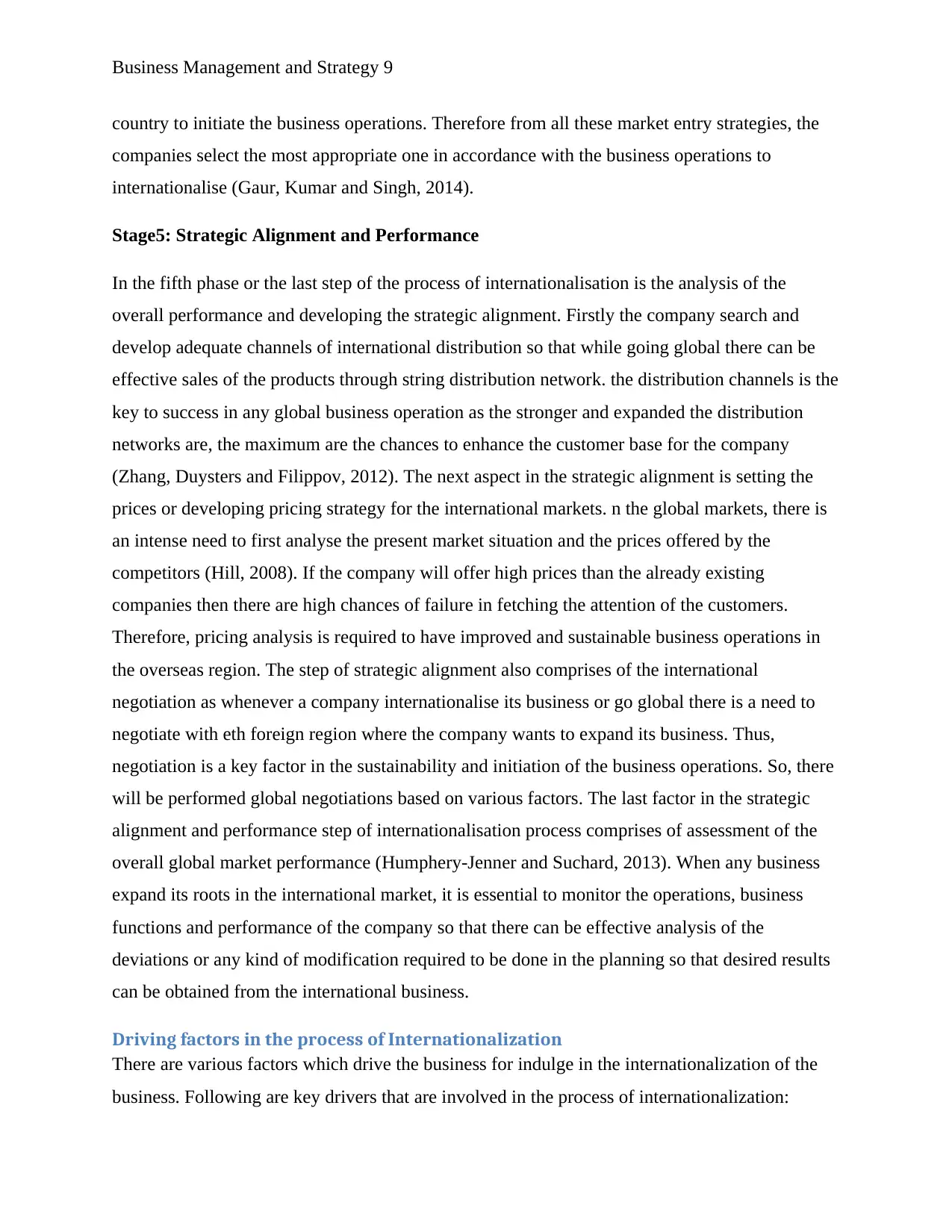
Business Management and Strategy 9
country to initiate the business operations. Therefore from all these market entry strategies, the
companies select the most appropriate one in accordance with the business operations to
internationalise (Gaur, Kumar and Singh, 2014).
Stage5: Strategic Alignment and Performance
In the fifth phase or the last step of the process of internationalisation is the analysis of the
overall performance and developing the strategic alignment. Firstly the company search and
develop adequate channels of international distribution so that while going global there can be
effective sales of the products through string distribution network. the distribution channels is the
key to success in any global business operation as the stronger and expanded the distribution
networks are, the maximum are the chances to enhance the customer base for the company
(Zhang, Duysters and Filippov, 2012). The next aspect in the strategic alignment is setting the
prices or developing pricing strategy for the international markets. n the global markets, there is
an intense need to first analyse the present market situation and the prices offered by the
competitors (Hill, 2008). If the company will offer high prices than the already existing
companies then there are high chances of failure in fetching the attention of the customers.
Therefore, pricing analysis is required to have improved and sustainable business operations in
the overseas region. The step of strategic alignment also comprises of the international
negotiation as whenever a company internationalise its business or go global there is a need to
negotiate with eth foreign region where the company wants to expand its business. Thus,
negotiation is a key factor in the sustainability and initiation of the business operations. So, there
will be performed global negotiations based on various factors. The last factor in the strategic
alignment and performance step of internationalisation process comprises of assessment of the
overall global market performance (Humphery-Jenner and Suchard, 2013). When any business
expand its roots in the international market, it is essential to monitor the operations, business
functions and performance of the company so that there can be effective analysis of the
deviations or any kind of modification required to be done in the planning so that desired results
can be obtained from the international business.
Driving factors in the process of Internationalization
There are various factors which drive the business for indulge in the internationalization of the
business. Following are key drivers that are involved in the process of internationalization:
country to initiate the business operations. Therefore from all these market entry strategies, the
companies select the most appropriate one in accordance with the business operations to
internationalise (Gaur, Kumar and Singh, 2014).
Stage5: Strategic Alignment and Performance
In the fifth phase or the last step of the process of internationalisation is the analysis of the
overall performance and developing the strategic alignment. Firstly the company search and
develop adequate channels of international distribution so that while going global there can be
effective sales of the products through string distribution network. the distribution channels is the
key to success in any global business operation as the stronger and expanded the distribution
networks are, the maximum are the chances to enhance the customer base for the company
(Zhang, Duysters and Filippov, 2012). The next aspect in the strategic alignment is setting the
prices or developing pricing strategy for the international markets. n the global markets, there is
an intense need to first analyse the present market situation and the prices offered by the
competitors (Hill, 2008). If the company will offer high prices than the already existing
companies then there are high chances of failure in fetching the attention of the customers.
Therefore, pricing analysis is required to have improved and sustainable business operations in
the overseas region. The step of strategic alignment also comprises of the international
negotiation as whenever a company internationalise its business or go global there is a need to
negotiate with eth foreign region where the company wants to expand its business. Thus,
negotiation is a key factor in the sustainability and initiation of the business operations. So, there
will be performed global negotiations based on various factors. The last factor in the strategic
alignment and performance step of internationalisation process comprises of assessment of the
overall global market performance (Humphery-Jenner and Suchard, 2013). When any business
expand its roots in the international market, it is essential to monitor the operations, business
functions and performance of the company so that there can be effective analysis of the
deviations or any kind of modification required to be done in the planning so that desired results
can be obtained from the international business.
Driving factors in the process of Internationalization
There are various factors which drive the business for indulge in the internationalization of the
business. Following are key drivers that are involved in the process of internationalization:
Paraphrase This Document
Need a fresh take? Get an instant paraphrase of this document with our AI Paraphraser
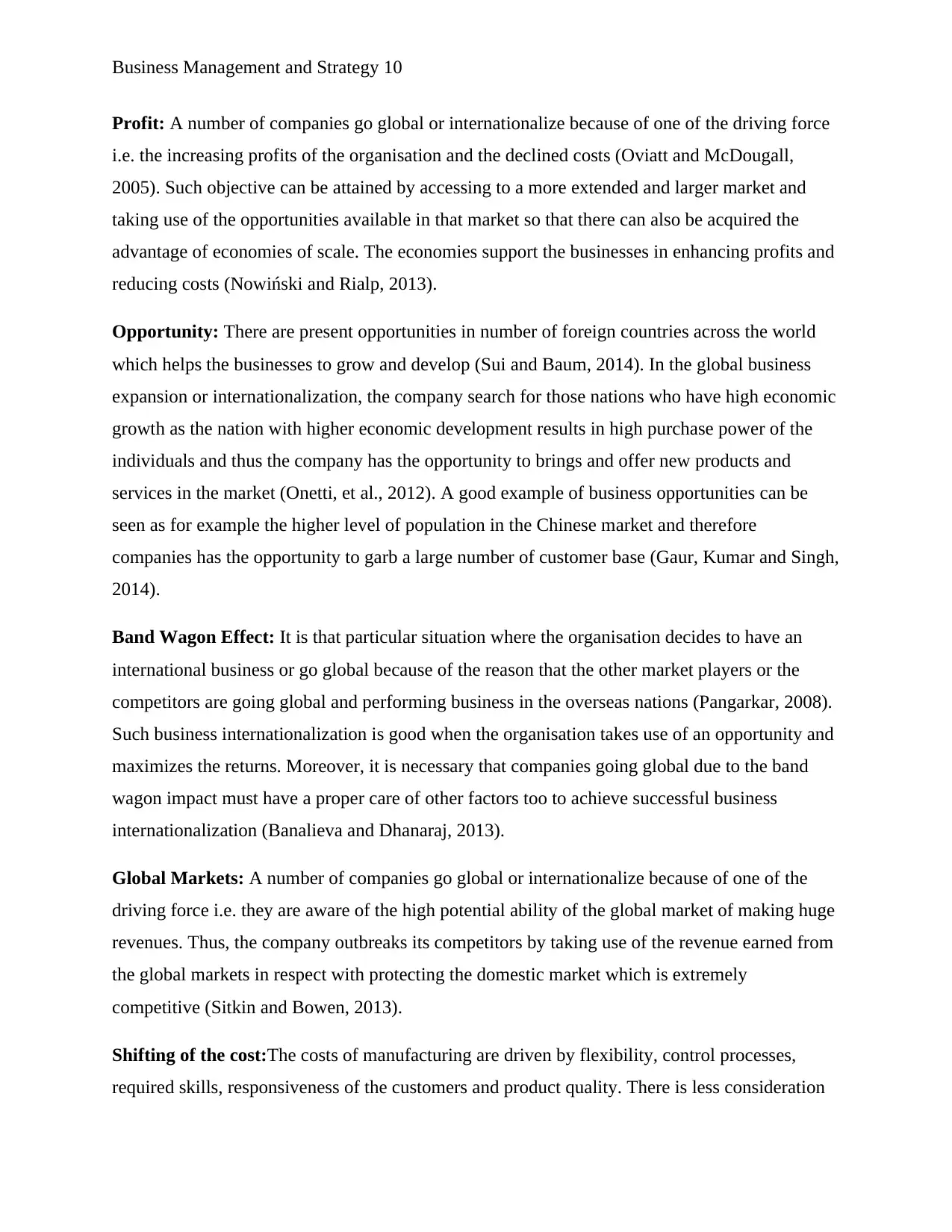
Business Management and Strategy 10
Profit: A number of companies go global or internationalize because of one of the driving force
i.e. the increasing profits of the organisation and the declined costs (Oviatt and McDougall,
2005). Such objective can be attained by accessing to a more extended and larger market and
taking use of the opportunities available in that market so that there can also be acquired the
advantage of economies of scale. The economies support the businesses in enhancing profits and
reducing costs (Nowiński and Rialp, 2013).
Opportunity: There are present opportunities in number of foreign countries across the world
which helps the businesses to grow and develop (Sui and Baum, 2014). In the global business
expansion or internationalization, the company search for those nations who have high economic
growth as the nation with higher economic development results in high purchase power of the
individuals and thus the company has the opportunity to brings and offer new products and
services in the market (Onetti, et al., 2012). A good example of business opportunities can be
seen as for example the higher level of population in the Chinese market and therefore
companies has the opportunity to garb a large number of customer base (Gaur, Kumar and Singh,
2014).
Band Wagon Effect: It is that particular situation where the organisation decides to have an
international business or go global because of the reason that the other market players or the
competitors are going global and performing business in the overseas nations (Pangarkar, 2008).
Such business internationalization is good when the organisation takes use of an opportunity and
maximizes the returns. Moreover, it is necessary that companies going global due to the band
wagon impact must have a proper care of other factors too to achieve successful business
internationalization (Banalieva and Dhanaraj, 2013).
Global Markets: A number of companies go global or internationalize because of one of the
driving force i.e. they are aware of the high potential ability of the global market of making huge
revenues. Thus, the company outbreaks its competitors by taking use of the revenue earned from
the global markets in respect with protecting the domestic market which is extremely
competitive (Sitkin and Bowen, 2013).
Shifting of the cost:The costs of manufacturing are driven by flexibility, control processes,
required skills, responsiveness of the customers and product quality. There is less consideration
Profit: A number of companies go global or internationalize because of one of the driving force
i.e. the increasing profits of the organisation and the declined costs (Oviatt and McDougall,
2005). Such objective can be attained by accessing to a more extended and larger market and
taking use of the opportunities available in that market so that there can also be acquired the
advantage of economies of scale. The economies support the businesses in enhancing profits and
reducing costs (Nowiński and Rialp, 2013).
Opportunity: There are present opportunities in number of foreign countries across the world
which helps the businesses to grow and develop (Sui and Baum, 2014). In the global business
expansion or internationalization, the company search for those nations who have high economic
growth as the nation with higher economic development results in high purchase power of the
individuals and thus the company has the opportunity to brings and offer new products and
services in the market (Onetti, et al., 2012). A good example of business opportunities can be
seen as for example the higher level of population in the Chinese market and therefore
companies has the opportunity to garb a large number of customer base (Gaur, Kumar and Singh,
2014).
Band Wagon Effect: It is that particular situation where the organisation decides to have an
international business or go global because of the reason that the other market players or the
competitors are going global and performing business in the overseas nations (Pangarkar, 2008).
Such business internationalization is good when the organisation takes use of an opportunity and
maximizes the returns. Moreover, it is necessary that companies going global due to the band
wagon impact must have a proper care of other factors too to achieve successful business
internationalization (Banalieva and Dhanaraj, 2013).
Global Markets: A number of companies go global or internationalize because of one of the
driving force i.e. they are aware of the high potential ability of the global market of making huge
revenues. Thus, the company outbreaks its competitors by taking use of the revenue earned from
the global markets in respect with protecting the domestic market which is extremely
competitive (Sitkin and Bowen, 2013).
Shifting of the cost:The costs of manufacturing are driven by flexibility, control processes,
required skills, responsiveness of the customers and product quality. There is less consideration
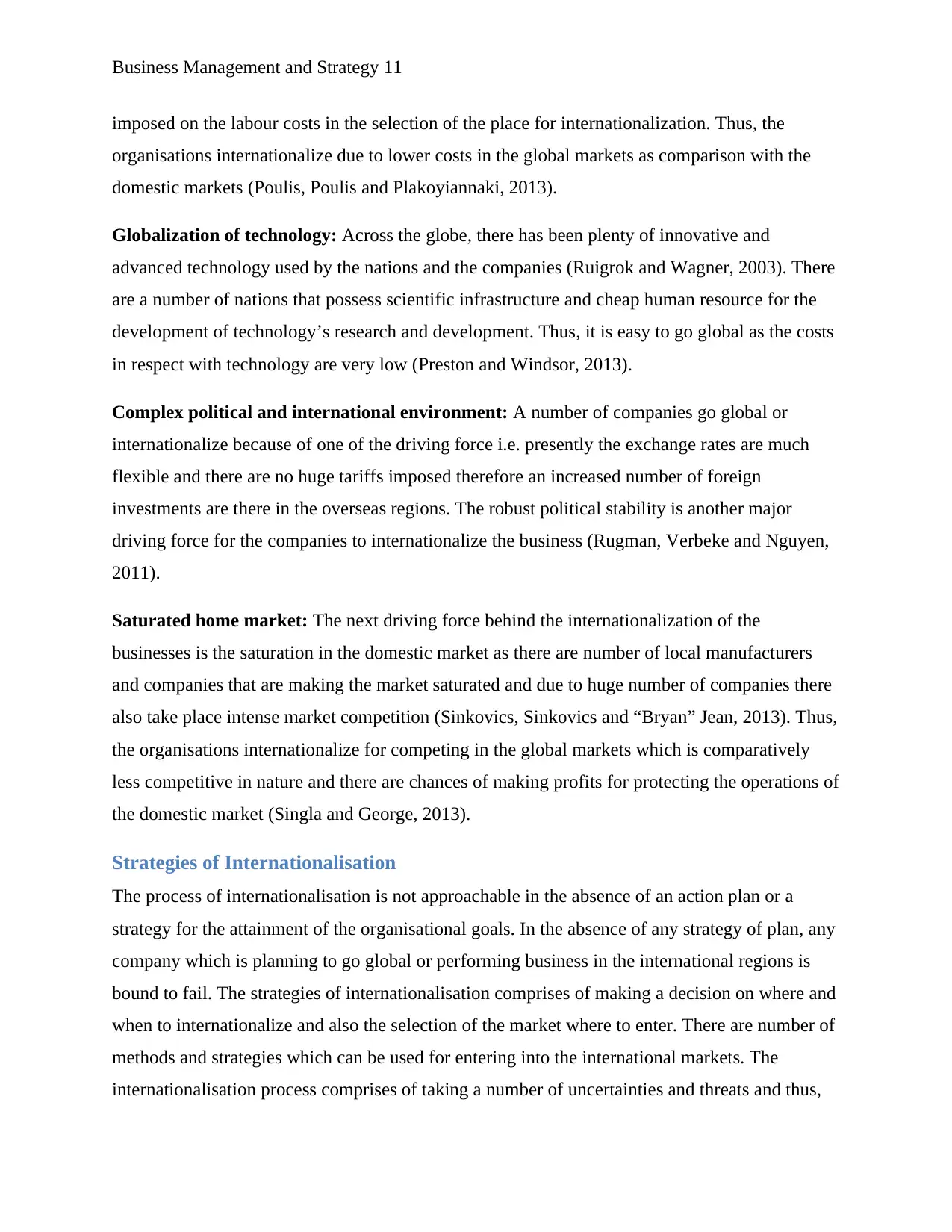
Business Management and Strategy 11
imposed on the labour costs in the selection of the place for internationalization. Thus, the
organisations internationalize due to lower costs in the global markets as comparison with the
domestic markets (Poulis, Poulis and Plakoyiannaki, 2013).
Globalization of technology: Across the globe, there has been plenty of innovative and
advanced technology used by the nations and the companies (Ruigrok and Wagner, 2003). There
are a number of nations that possess scientific infrastructure and cheap human resource for the
development of technology’s research and development. Thus, it is easy to go global as the costs
in respect with technology are very low (Preston and Windsor, 2013).
Complex political and international environment: A number of companies go global or
internationalize because of one of the driving force i.e. presently the exchange rates are much
flexible and there are no huge tariffs imposed therefore an increased number of foreign
investments are there in the overseas regions. The robust political stability is another major
driving force for the companies to internationalize the business (Rugman, Verbeke and Nguyen,
2011).
Saturated home market: The next driving force behind the internationalization of the
businesses is the saturation in the domestic market as there are number of local manufacturers
and companies that are making the market saturated and due to huge number of companies there
also take place intense market competition (Sinkovics, Sinkovics and “Bryan” Jean, 2013). Thus,
the organisations internationalize for competing in the global markets which is comparatively
less competitive in nature and there are chances of making profits for protecting the operations of
the domestic market (Singla and George, 2013).
Strategies of Internationalisation
The process of internationalisation is not approachable in the absence of an action plan or a
strategy for the attainment of the organisational goals. In the absence of any strategy of plan, any
company which is planning to go global or performing business in the international regions is
bound to fail. The strategies of internationalisation comprises of making a decision on where and
when to internationalize and also the selection of the market where to enter. There are number of
methods and strategies which can be used for entering into the international markets. The
internationalisation process comprises of taking a number of uncertainties and threats and thus,
imposed on the labour costs in the selection of the place for internationalization. Thus, the
organisations internationalize due to lower costs in the global markets as comparison with the
domestic markets (Poulis, Poulis and Plakoyiannaki, 2013).
Globalization of technology: Across the globe, there has been plenty of innovative and
advanced technology used by the nations and the companies (Ruigrok and Wagner, 2003). There
are a number of nations that possess scientific infrastructure and cheap human resource for the
development of technology’s research and development. Thus, it is easy to go global as the costs
in respect with technology are very low (Preston and Windsor, 2013).
Complex political and international environment: A number of companies go global or
internationalize because of one of the driving force i.e. presently the exchange rates are much
flexible and there are no huge tariffs imposed therefore an increased number of foreign
investments are there in the overseas regions. The robust political stability is another major
driving force for the companies to internationalize the business (Rugman, Verbeke and Nguyen,
2011).
Saturated home market: The next driving force behind the internationalization of the
businesses is the saturation in the domestic market as there are number of local manufacturers
and companies that are making the market saturated and due to huge number of companies there
also take place intense market competition (Sinkovics, Sinkovics and “Bryan” Jean, 2013). Thus,
the organisations internationalize for competing in the global markets which is comparatively
less competitive in nature and there are chances of making profits for protecting the operations of
the domestic market (Singla and George, 2013).
Strategies of Internationalisation
The process of internationalisation is not approachable in the absence of an action plan or a
strategy for the attainment of the organisational goals. In the absence of any strategy of plan, any
company which is planning to go global or performing business in the international regions is
bound to fail. The strategies of internationalisation comprises of making a decision on where and
when to internationalize and also the selection of the market where to enter. There are number of
methods and strategies which can be used for entering into the international markets. The
internationalisation process comprises of taking a number of uncertainties and threats and thus,
⊘ This is a preview!⊘
Do you want full access?
Subscribe today to unlock all pages.

Trusted by 1+ million students worldwide
1 out of 45
Related Documents
Your All-in-One AI-Powered Toolkit for Academic Success.
+13062052269
info@desklib.com
Available 24*7 on WhatsApp / Email
![[object Object]](/_next/static/media/star-bottom.7253800d.svg)
Unlock your academic potential
Copyright © 2020–2025 A2Z Services. All Rights Reserved. Developed and managed by ZUCOL.




